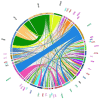New Insight into the Genome-Wide Diversity and Admixture of Six Colombian Sheep Populations
- PMID: 36011325
- PMCID: PMC9407362
- DOI: 10.3390/genes13081415
New Insight into the Genome-Wide Diversity and Admixture of Six Colombian Sheep Populations
Abstract
Creole sheep represent a strategic genetic resource for populations living in marginal areas under financial restrictions on the American continent. Six Colombian sheep breeds (two wool (BCL-Boyacá and NCL-Nariño, 12 and 14 samples) and four hair (OPCE-Ethiopian, 54 samples; OPCS-Sudan, 74 samples; OPCP-Pelibeuy, 59 samples; OPCW-Wayúu, 24 samples) were genotyped using the Illumina Ovine SNP50 BeadChip. Data was also included from international 44 breeds from International Sheep Genomics Consortium (ISGC) and from data published in previous a previous work on the Caribbean and African breeds. Although geographically separated, wool (NCL, BCL) and hair types (OPCE, OPCS, OPCW) presented little genetic differentiation (FST 0.05) at a global level but several groups of animals separated suggesting local clustering due to geographical isolation. The OPCP underwent a recent crossing with Mexican Pelibuey, explaining its differentiation. Findings in this work such as the proximity to West African Djallonké (WAD) and Barbados Black Belly (BBB), suggest different introductions of African type animals from the Caribbean region on a pre-existing genetic basis formed by animals deriving from the first importations coming from Europe in colonial times. As expected, Colombian wool breeds showed, in particular in Admixture software results, a greater genomic component in common with European breeds and in particular with Iberian ones (Churra). This study provides a basis for future research into the genetic diversity within and between the Colombian sheep breeds analysed, and scientific data for policy decisions on Farm Animal Genetic Resources (FAnGR).
Keywords: Africa; Ovis Aries; SNPs; South America; admixture; animal genetic resources; differentiation; genomics.
Conflict of interest statement
The authors declare no conflict of interest.
Figures










References
-
- Spangler G.L., Rosen B.D., Ilori M.B., Hanotte O., Kim E.-S., Sonstegard T.S., Burke J.M., Morgan J.L.M., Notter D.R., Van Tassell C.P. Whole genome structural analysis of Caribbean hair sheep reveals quantitative link to West African ancestry. PLoS ONE. 2017;12:e0179021. doi: 10.1371/journal.pone.0179021. - DOI - PMC - PubMed
-
- Bravo S., Larama G., Quiñones J., Paz E., Rodero E., Sepúlveda N. Genetic diversity and phylogenetic relationship among araucana creole sheep and Spanish sheep breeds. Small Rumin. Res. 2019;172:23–30. doi: 10.1016/j.smallrumres.2019.01.007. - DOI
-
- Vivas N., Landi V., Flórez J.M., Yanez M.B., Franco L.Á.J.R.M.C. Diversidad genética de ovinos criollos colombianos. Rev. MVZ Córdoba. 2020;25:e2185. doi: 10.21897/rmvz.2185. - DOI
Publication types
MeSH terms
LinkOut - more resources
Full Text Sources
Research Materials
Miscellaneous

